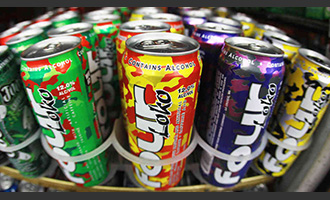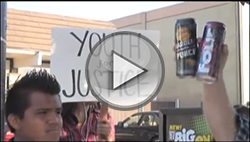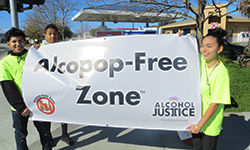Home
Search
STOP ALCOPOPS
Alcopops are sweet, often fruit-flavored or fizzy alcoholic drinks. They closely resemble soda or energy drinks, and many contain up to 12% ABV. Alcopops are industry's transition for youth (especially girls), from soda to alcohol, fueling alcohol-related harm. Our Alcopop-Free Zone®
campaign seeks to ban alcopop sales entirely.
Alcopops FAQs
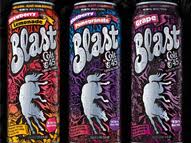 1. What are alcopops?
1. What are alcopops?
Prevention advocates use the term “alcopops” for sweetened alcoholic beverages that are usually sold in single-serving bottles or cans. They are often fruit-flavored and/or bubbly, and resemble soda or other soft drinks. The first generation of alcopops contained about 5% alcohol by volume. Recently, alcopop producers have pushed their alcohol levels to 12% or more. Up to half of the alcohol in alcopops is derived from distilled spirits. Alcopops are also known in the industry as “flavored malt beverages (FMBs)” “malternatives,” and “flavored alcoholic beverages (FABs).”
Supersized alcopops (the latest rendition of this product that emerged when alcoholic energy drinks were outlawed) are packaged and marketed as single-serve, ready-to-drink alcoholic beverages. They are typically 24 ounces and have a high alcohol content (up to 12% by volume), the equivalent of 4.7 servings of alcohol.
2. How are alcopops made?
While the industry keeps most manufacturing information secret, from what little we do know, alcopops apparently start out as beer. Manufacturers remove the color, taste, and much of the alcohol from the beer, leaving mostly water. Then, they add flavorings, sweeteners, and distilled alcohol for the finished product, which is packaged in youth-oriented, bright, eye-catching colors and graphics.
3. When did alcopops first come on the scene?
Alcopops have been around since the mid-1990s. Zima, introduced by Coors in 1994, was one of the first alcopop products. Even then, popular culture references made fun of Zima’s appeal among young girls. Skits on Saturday Night Live featured a married man attempting to seduce a babysitter with Zima, and a teenage girl hosting a party and offering Zima to her friends. Wine-based coolers like Gallo’s Bartles & Jaymes, switched to a beer base in the 1990s and are now known as “flavored malt beverages.”
In 2002, Sparks (the first alcopop product to include caffeine in its formula) was introduced. MillerCoors bought the rights to the product in 2006 and considered it “the innovator and creator of energy beer. The category didn’t really exist before Sparks came out.”(1). Anheuser-Busch InBev soon joined the caffeinated alcoholic beverage market with Tilt, an alcopop with varying alcohol content by volume (between 6-10%), in 16- and 24-ounce containers. In 2008, in response to pressure from many state attorneys general, both MillerCoors and Anheuser-Busch InBev removed caffeine from their respective products and introduced newly reformulated, caffeine-free alcopops.
A new public health threat emerged in 2010: high-alcohol alcopops in supersized, single-serving containers. Prior to the U.S. Food and Drug Administration ruling in November 2010, Anheuser-Busch InBev’s Tilt, Phusion Project’s Four Loko, and United Brands’ Joose removed caffeine from their alcoholic energy drink products. However, these new caffeine-free alcopops were sold in 24-ounce, single-serving cans with more than double the alcohol content. Even without caffeine or other stimulants these products remain dangerous, fueling underage drinking and related harm.
4. What companies make alcopops?
Manufacturers include Anheuser-Busch InBev, the world’s largest brewer, and Diageo, the largest multinational beer, wine, and spirits company. The top selling alcopop brands in 2009 were Mike’s Hard Beverage (Mike’s Hard Beverage), Sparks (MillerCoors), Smirnoff Twisted V (Diageo-Guinness), Smirnoff Ice (Diageo-Guinness), and Bartles & Jaymes (E & J Gallo Winery) (2).
5. Who is drinking alcopops?
Underage girls drink alcopops more than any other type of alcoholic beverage (3). While the industry says these drinks are intended for adults, women 21 and older rank alcopops as their least consumed alcoholic beverage. About one-third of teenage girls ages 12 to 18, and one-fifth of teenage boys, have tried alcopops. Youth and young adults call alcopops “cheerleader beer” and “chick beer.”
6. Why are alcopops of such great concern?
Alcopops fuel the epidemic of underage drinking. Because they don’t taste, smell, or look like alcohol, alcopops serve as a transition or bridge from soft drinks to alcohol, especially for young girls. The packaging and promotion of alcopops has led to a misperception these products are “lighter” than other alcohol products. Young people report drinking alcopops because they are easier to conceal and “go down easy.” (4)
Increased violence is another concern. A recent University of California Riverside study shows that as the percentage of cooler space for alcopops in alcohol outlets increased, so did the crime rates in those neighborhoods (5). Recommendations from the report include regulating single-serve alcohol beverage container availability as a measure to reduce alcohol-related harm.
7. What can states do to stop the sales of alcopops?
State leaders should consider restricting these products as a public health and safety measure. Alcohol Justice’s model legislation offers language for this necessary step toward getting these products off the shelves. State-level bans are essential to prevent the sale of these dangerous products, reduce levels of related harm, and protect young people in their communities.
References
1. Marikar S. Energy beers boost brewing industry. ABC News/Money. July 12, 2006. Available at: http://abcnews.go.com/Business/FunMoney/story?id=2179563&page=1. Accessed August 12, 2011.
2. The Beverage Information Group. Handbook Advance 2010: A special report on spirits, wine and beer sales and consumption in 2009. The Beverage Information Group Publications: Norwalk, CT.
3. American Medical Association. ‘Girlie Drinks… women’s diseases’. 2004. Available at: http://www.alcoholpolicymd.com/pdf/girlie_drinks_survey%20.pdf. Accessed September 14, 2011.
4. Alcohol Justice (formerly Marin Institute). The Cost of Alcopops to Youth and California. 2007. Available at:http://www.alcoholjustice.org/images/stories/pdfs/The_Cost_of_Alcopops_to_Youth_and_California.pdf. Accessed September 14, 2011.
5. Parker RN, McCaffree KJ, and Skiles D. The impact of retail practices on violence: The case of single serve alcohol beverage containers. 2011. Drug and Alcohol Review. Vol.30:496-504.
Alcopops Legislation Tracker
Publications
Read about alcopops and our efforts to keep them out of youths' hands.
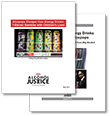
OUR CAMPAIGNS
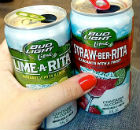 |
Stop Alcopops Our campaign seeks to ban alcopop sales entirely. |
 |
Advertising We support strong advertising regulations and enforcement. |
 |
Charge for Harm We support state and federal increases in alcohol taxes. |
 |
State Control & Regulation We support state authority to regulate alcohol sales. |
 |
Point .05 Saves Lives We support state efforts to lower the BAC limit to .05. |
Help us hold Big Alcohol accountable for the harm its products cause.
| GET ACTION ALERTS AND eNEWS |
STAY CONNECTED    |
CONTACT US 24 Belvedere St. San Rafael, CA 94901 415-456-5692 |
SUPPORT US Terms of Service & Privacy Policy |
Copyright © 2024 Alcohol Justice. All Rights Reserved.
Joomla! is Free Software released under the GNU General Public License.





